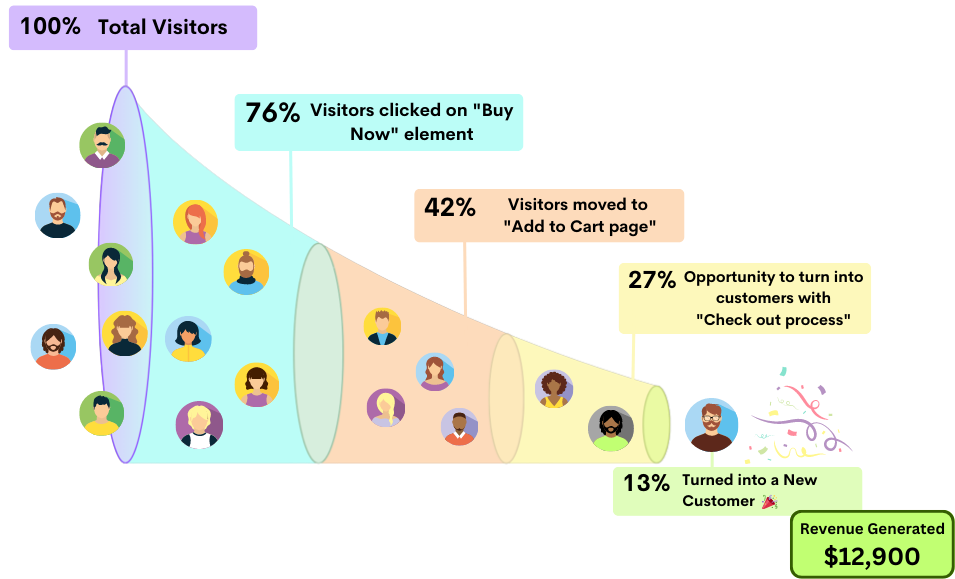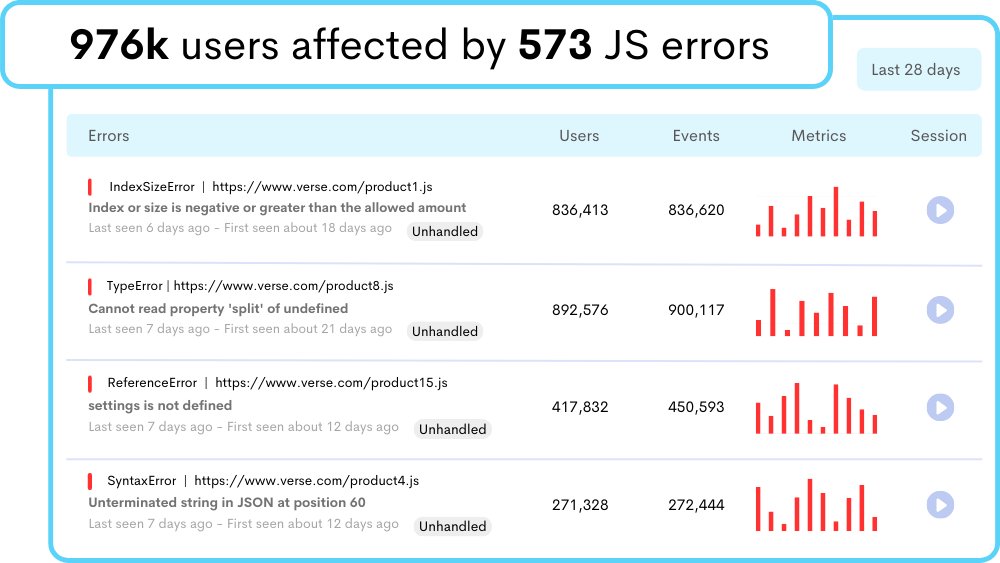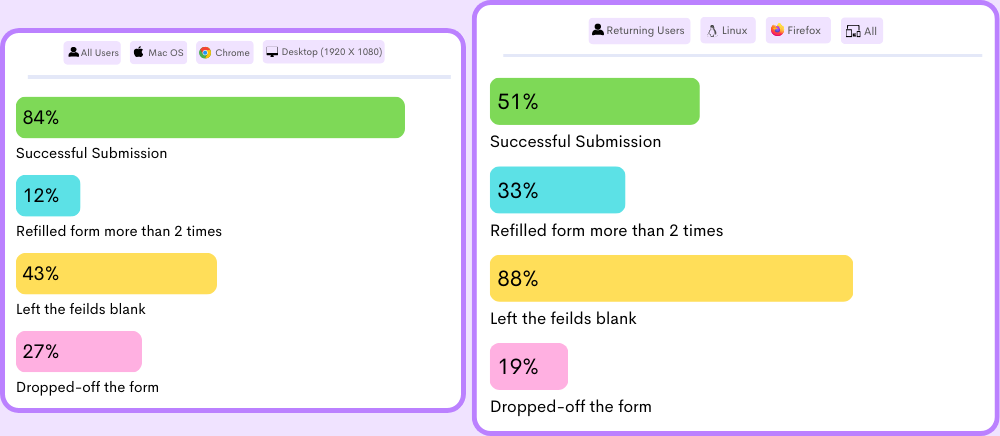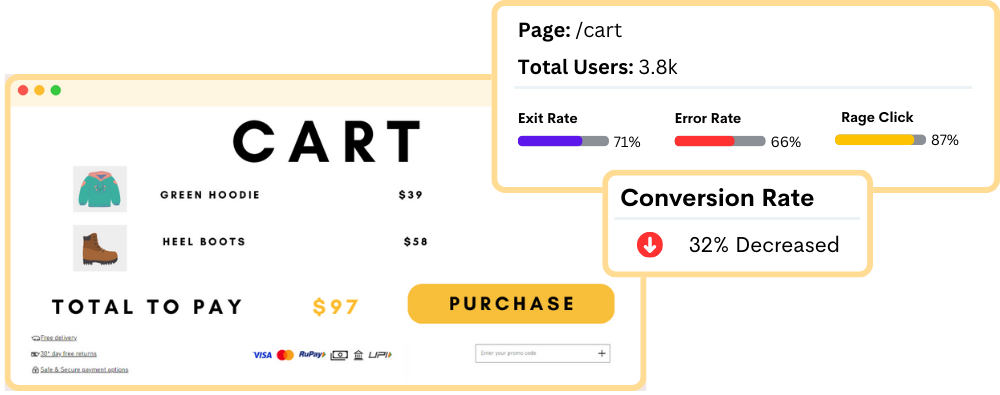
Win more product engagement
ReplayBird provides surface-level metrics, insights, and actionable strategies that any team can leverage to boost revenue, interaction, and development. Analyze all digital interactions on your website.
Benefits
 Save Time
Save Time Instantly capture and analyze behaviors as they happen in real-time.
 Enhanced User Experience
Enhanced User Experience Gain comprehensive customer insights for a complete understanding.
 Boost Revenue
Boost Revenue Identify emerging possibilities to drive revenue growth
 Customer Satisfaction
Customer Satisfaction Remove barriers and delight customers with effortless interactions.
 Pinpoint and Resolve Bugs
Pinpoint and Resolve Bugs Effectively address, troubleshoot, and resolve problems for prompt resolution.
 Privacy-Driven Integration
Privacy-Driven Integration Prioritize privacy and secure integration for driving continuous innovation.
Want to Interpret the changes that your product needs most?
Achieve strong product outcomes by combining user-focused design, business savvy, and technological expertise.

Watch your product's life cycle with the user journey
Guide your product over multiple iterations and ensure that the market's voice is listened to and understood to focus marketing efforts.

Create segments on your priority product
Stop wasting time on all the sessions. ReplayBird provides you with metrics on where your product has interacted with the users. Improve your product to get more engagement with your users.
Get your free trial now!
End struggling to develop your Product
Influence the success of your product, by finding the right spot on your website that works on your product, evaluating the potential market, they can then try to address it if there’s a significant enough opportunity.
Go from insight to action
Conversion rate optimization
User engagement tracking
Customer support
App Analytics
Usability testing
Website tracking
UX design issues
Marketing funnels
Application debugging
Performance marketing
Product experience insights
Engagement patterns
Better Insights. Grow Faster.
Ready to understand your customer journeys like never before?
Frequently Asked Questions
During the prototyping and design validation phases, session recordings can be a useful tool to observe how users interact with mockups, wireframes, or low-fidelity prototypes.
This can provide designers with insights into what is working well and what areas need improvement before the product is fully developed.
For example, designers can use session replay to observe how users navigate a prototype, what areas of the prototype are causing confusion, and what interactions are most frequently used.
This information can then be used to inform design decisions and enhance the user experience.
Session recordings can also be used to validate design concepts by observing how users react to new features or changes to the user interface. By comparing the user experience before and after the change, designers can determine if the change has had the desired impact on the user experience.
Session replay may be used to watch user activities with native mobile applications, such as tapping buttons, browsing through menus, and traveling through multiple displays. This can give useful information on how users interact with the app and what areas create confusion or annoyance.
Session recordings for mobile applications, like web-based products, may be used to validate design decisions, acquire qualitative user input, and enhance the user experience.
Designers, for example, might utilize session replay to study how users engage with a new feature and assess if it meets their needs. If the feature is not being utilized as intended, the designer can make changes to make it more usable.
- User Behavior: Product analytics can help product managers understand how users are interacting with the product, including what features are being used most, what pages are being visited, and how users are navigating the product. This information can be used to inform design decisions and make improvements to the user experience.
- Customer Segmentation: Product analytics can also segment users based on behavior and demographics, allowing product management to understand the needs of different user groups and tailor the product experience accordingly.
- User Feedback: Product analytics can also gather qualitative user feedback by observing user reactions, emotions, and behaviors as they interact with the product. This information can inform design decisions and enhance the user experience.
- Conversion Optimization: Product analytics can also be used to optimize the conversion funnel, identifying areas where users are dropping off and making improvements to increase web conversion rates.
- Feature Adoption: Product analytics for product managers track the adoption of new features, allowing them to determine if the feature is meeting user needs and if any improvements are needed.
Funnel analytics may be one of the analytics that product managers use to understand where users leave the customer journey, such as at the checkout page or throughout the onboarding process. Product management may minimize customer turnover and boost customer engagement by addressing these pain points.
In a production environment, error tracking is used to monitor program performance and discover any errors that may interfere with the user experience.
By tracking errors in production, teams may immediately discover and rectify issues, enhancing the application's overall dependability and performance.
Error monitoring may also give significant insights into the fundamental cause of an error, allowing teams to make adjustments to avoid similar problems in the future.
This is especially valuable for companies with several teams working on separate projects since it gives a consolidated view of all errors and makes collaboration and information sharing easier.
Furthermore, error-tracking programs frequently interact with other products and services, such as source control systems and bug-tracking tools, making it simple to include error monitoring in current processes.
These insights can be used to forecast future customer behavior and make informed design decisions based on expected customer behavior.
Funnel analytics provides valuable insights into the customer journey, allowing product designers to make informed design decisions and forecast future customer behavior.
Using funnel analytics, product designers can optimize the customer journey to increase customer engagement and web conversion rates.
This helps designers to identify and fix issues before they become problems and to continuously refine and improve their designs based on user data and feedback.
Try ReplayBird for free now
Free 14-day trial. No credit card required. Easy setup.